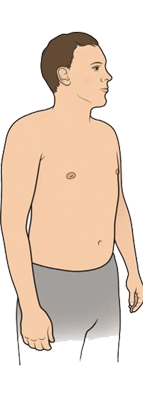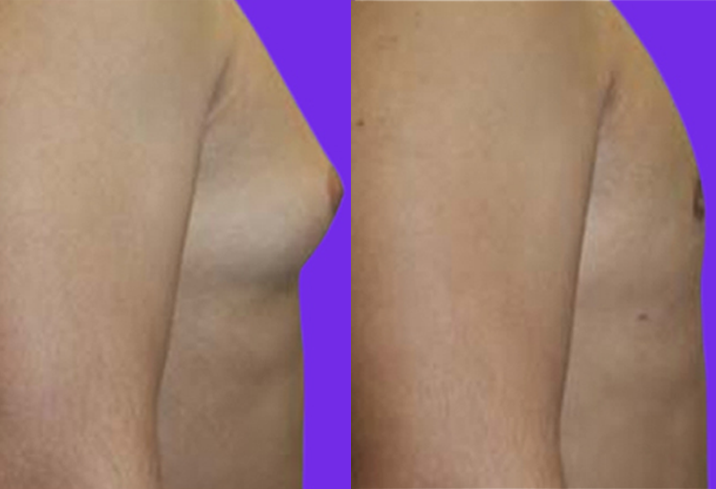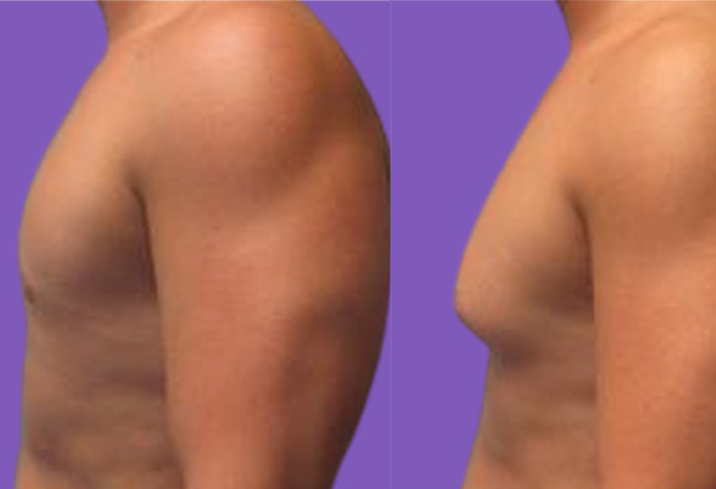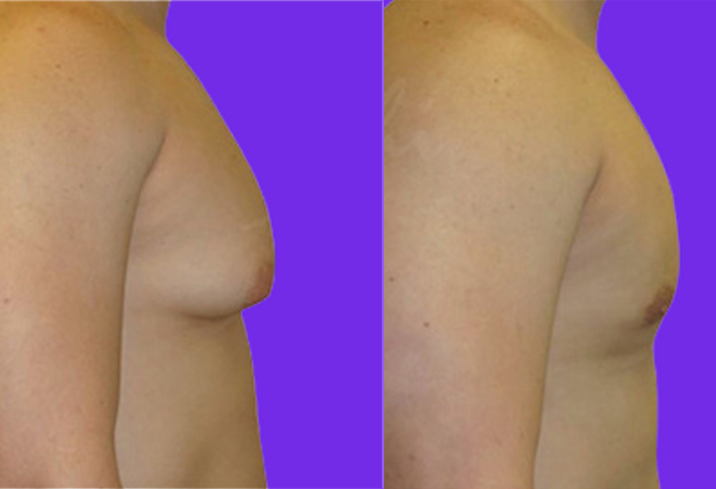If you want to undergo gynecomastia surgery in Delhi by the best male breast reduction specialist surgeon in Delhi (India) at our clinic, we provides the best & specialist cosmetic, and plastic surgeon in New Delhi, South Delhi (India) to get rid of enlarged breast tissues and gland and sometime fat also using liposuction!
Characterized by enlarged breasts in men, gynecomastia affects 24 percent to 65 percent of men in the age group between 50 and 80. Generally, gynecomastia is more of an embarrassing condition rather than a serious problem. Still, some men or boys may experience discomfort or pain in the affected area. While it goes away on its own in most situations (especially in boys), you may also consider surgical removal of enlarged breast tissues. We have the best gynecomastia surgeon in Delhi who can help you get rid of male breasts.
What is gynecomastia?
Gynecomastia refers to a condition involving enlargement or overdevelopment of the breast gland tissue in men or boys. The enlargement is mostly seen in boys in puberty, mostly due to an imbalance of the hormones including testosterone and estrogen. However, newborn babies and older men are also vulnerable to developing enlarged breasts or gynecomastia.
Who may develop gynecomastia?
Unlike what most people think, estrogen is not an exclusively female hormone. Men may also have it or produce it (though usually in small quantities) at different stages in their lives. And, this is the reason men develop enlarged breasts when testosterone and estrogen balance disrupts.
Gynecomastia can affect men at different life stages, including:
Birth: Research studies suggest that over 50 percent of male babies are born with enlarged breasts, or have breast buds. Mother’s estrogen levels are responsible for this condition in newborns. In most cases, the enlarged breasts disappear automatically within a few weeks.
Puberty or Adolescence: More than half of boys entering the reproductive age tend to develop some degree of breast tissue enlargement. Hormones imbalances that include a decrease in the amount of testosterone and increased production of estrogen are responsible for the overdevelopment of breast tissue. The breasts may become normal as soon as the hormone balance is restored. However, the process may take anywhere between six months and two years.
Adulthood: Enlarged breasts or gynecomastia is also prevalent in men over 50. It is due to the less production of testosterone in men as they age. In addition, increased body fat may also stimulate estrogen production and the growth of breast tissue.
What are the common signs/symptoms of gynecomastia?
Gynecomastia may stem as a lump or fatty tissue beneath the nipple. It can appear in one or more breasts and may be sore at times. While most adult men don’t report symptoms of the condition, some of the common signs and symptoms may include:
- Pain, especially experienced by adolescents
- Breast tenderness
- Swollen breast tissue
- Nipple sensitivity when rubbed against clothes
Make sure if see a doctor if you experience:
- Pain or tenderness
- Swelling
- Nipple discharge in one or both breasts
The indicators of gynecomastia may match some other problem or medical conditions as well. Therefore, expert advice is mandatory for a confirmed diagnosis.
What causes gynecomastia?
Gynecomastia may arise from a fall in the amount of the testosterone hormone in comparison with estrogen. The decrease can be a result of conditions that reduce the amount of testosterone or inhibit the effect of testosterone. It may also be caused due to increased secretion of estrogen hormone.
Different factors may contribute to the disruption of this hormone balance, which may include:
Health Conditions that Can Cause Gynecomastia
Several health conditions may lead to gynecomastia by disrupting the testosterone-estrogen balance of hormones. These may include:
- Aging: As men (especially those who are overweight) age, decreased production of testosterone may lead to gynecomastia.
- Hypogonadism: It is associated with decreased production of testosterone production and pituitary insufficiency, which may contribute to gynecomastia.
- Hyperthyroidism: In this condition, there is an increased production of the hormone thyroxine by the thyroid gland, which affects the hormonal balance in men.
- Liver failure and cirrhosis: Medications used for treating liver problems and cirrhosis medications may also cause gynecomastia.
- Tumors: The tumors that involve the testes, pituitary gland, or adrenal glands may lead to the production of hormones that are linked to the male-female hormone balance.
- Kidney failure: Researchers suggest that around half the people undergoing dialysis experience hormonal changes associated with gynecomastia.
- Malnutrition and starvation: Lack of adequate nutrition drops the testosterone levels drop while not affecting the estrogen levels, which may result in a hormonal imbalance.
- Some herbal products, especially the plant oils (like tea tree or lavender), that are used in soaps, lotions, and shampoos may cause gynecomastia due to their weak estrogenic activity.
What are the Best Ways to Prevent Gynecomastia?
Gynecomastia in newborns and adolescents offers nearly nothing to control it. However, you can control some factors that are associated with a hormonal imbalance to minimize the risk of gynecomastia.
Feel free to consult with our expert gynecomastia surgeon in Delhi to know more about how to avoid gynecomastia.
How is Gynecomastia Diagnosed?
Our experienced gynecomastia surgeon in India diagnosed gynecomastia based on your symptoms. They also conduct a medical exam to confirm the diagnosis, which includes an evaluation of your breast tissue, genitals, and abdomen.
The common tests to diagnose gynecomastia include:
- Mammograms
- CT scan
- Chest X-rays
- Blood tests
- Testicular ultrasounds
- Tissue biopsies
- Magnetic resonance imaging (MRI) scans
- Computerized tomography (CT) scans
- Urine tests
In some cases, tests may not be needed for the diagnosis.
How is Gynecomastia Treated?
In most cases, gynecomastia is corrected on its own without treatment. However, people who have underlying conditions such as cirrhosis, hypogonadism, malnutrition, or cirrhosis may need treatment for the underlying treatment.
In adolescents with gynecomastia, normal hormone changes during puberty are the major cause of the condition. And, it often goes away without treatment within two years. But, treatment may be needed in cases where gynecomastia is accompanied by embarrassment, or significant pain and tenderness.
How Can Surgery Help Remove Excess Breast Tissue?
The surgical procedure to eliminate gynecomastia comprises the following steps:
Anesthesia
Our experienced male breast reduction surgeon in Delhi administer Anesthesia to make you feel comfortable during the surgical procedures. Depending on the type of surgery, they may choose from two options: general anesthesia or intravenous sedation.
Liposuction technique
The doctors may consider technique alone to treat gynecomastia in cases excess fatty tissue is responsible for the embarrassing condition. Liposuction procedure requires inserting a cannula and a thin hollow tube by way of many small incisions.
They then loosen the fat by moving the cannula back and forth in a controlled motion. The fat is then removed from the body through vacuum suction.
Excision technique
Expert gynecomastia surgeons consider excision techniques where they need to remove excess skin or glandular breast tissue to correct gynecomastia. Doctors can also consider excision if there is a need to reduce areola or to reposition the nipple for a more natural male contour.
Doctors may also use a combination of liposuction and excision techniques if the surgery demands.
Recovering from Gynecomastia Surgery
Be ready for the following arrangement for a few days after the surgery:
- The doctors will discharge you with dressings or bandages applied to your incisions after the successful completion of surgery.
- You will also have to carry an elastic bandage or support garment to minimize swelling and to support your new chest contour after surgery.
- You will have a small, thin tube temporarily placed under the skin to drain out any excess fluid or blood or fluid.
- You and your caretakers will receive specific instructions from the surgeons on how you can take care of the surgical site and drains.
- They will also instruct on how to apply medications for external use and be taken orally to aid healing.
- Adherence to medications is important because they help reduce the risk of infection while speeding up the healing process.
Don’t forget to resolve your queries from our plastic surgeons in Delhi, which may include:
- Time and schedule of medications prescribed for recovery
- When and how you should change/remove dressings/bandages
- When to come for removing stitches
- When to return to my normal activity and exercise
- When to come for follow-up care
Our expert cosmetic surgeons in Delhi will resolve your queries patiently and give you complete support during your recovery.
What Should You Expect from Gynecomastia Surgery?
The results of the surgery are usually permanent. However, people who have gynecomastia due to the use of certain medications may develop it again if they don’t discontinue their use. Also, those who have this condition due to weight gain would require maintaining a healthy weight to prevent the enlargement of breast tissues.
You can also seek advice from our cosmetic surgeons in Delhi on how to prevent gynecomastia. It is also important to seek immediate medical attention for problems like chest pains, shortness of breath, or an unusual heartbeat.
What is the Cost of Gynecomastia in Delhi, India?
Generally, gynecomastia surgery cost in Delhi or male breast reduction cost in Delhi may vary widely. However, it depends on the amount of fat to be removed, the technology used, and the miscellaneous expenses.
We have experienced cosmetic surgeons in Delhi, who offer the best gynecomastia cost in Delhi at the most affordable price. You can contact us now to know about our cost-effective male breast reduction surgery cost in Delhi.
FAQs about Gynecomastia
What causes gynecomastia?
While the exact cause of gynecomastia is unknown, it is primarily linked to hormonal imbalance, certain medications, and steroid use.
What should I expect from gynecomastia surgery?
Gynecomastia surgery results are immediate and permanent. However, it is important to avoid the causes responsible for the enlarged breast tissue.
What are the possible unpleasant experiences of gynecomastia surgery?
As discussed in the article, swelling, pain, and mucus discharge may sustain for a week or two. But you are good to resume your normal activities within 2 – 4 weeks. If you still experience discomfort, our expert gynecomastia surgeons in Delhi are at your disposal.
Can exercise alone help correct man boobs?
Exercise is a great way to achieve and maintain overall wellness and fitness. In the case of gynecomastia too, it can help you reduce excess stored fat on the chest but it may not prove effective in correcting your embarrassing shapes and sizes on your breast area.
How is gynecomastia treated?
We have discussed in detail our treatment section of the article. More than treatment, it’s about correction if other ways don’t work. You should consider surgery if it’s compromising your physical or mental health.
Are there any visible scars after surgery?
They are rare in most cases but even if they exist they will get disappeared within a few weeks.
Can man boobs return after surgery?
They may but only if you don’t take precautions and don’t address the causes that contribute to it.
Why should we consider gynecomastia surgery?
You should consider it only if it’s compromising your physical and most importantly emotional health. Physical health here means you are overweight and emotional health comes into play if your body structure makes you feel embarrassed and low in confidence.








